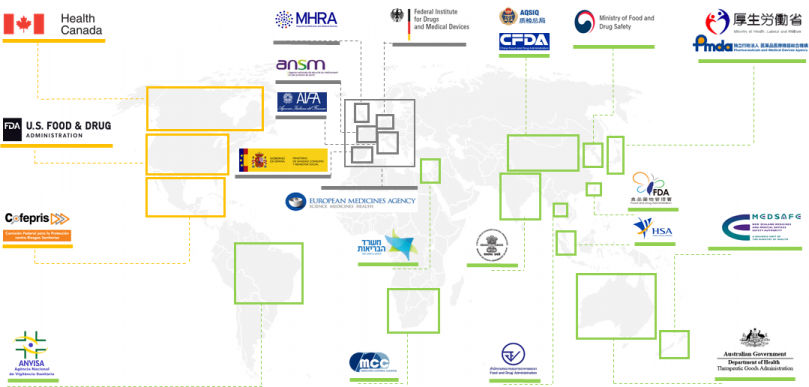Regulatory And Reimbursement Landscape For Medical Devices
Technical advances and innovation in design within the medical devices industry have prompted regulatory authorities to update the laws governing various aspects of the development, manufacturing, design and approval of such products. Further, it is imperative that various stages of medical device development and production are closely monitored and regulated in order to avoid serious and / or life-threatening consequences. In this regard, several regulatory agencies and organizations across the globe have established standard operating protocols, regarding the sale and use of these devices. Reimbursement is another integral aspect to the successful sale and distribution of medical devices. Similar to regulatory compliance, healthcare authorities require continued clinical and economic data collection, such as observational studies and cost benefit / use analyses, as well as dissemination of the information collected in deciding reimbursement for medical devices. Presently, almost every country has its own regulatory authority, which issues guidelines to regulate the development, distribution and reimbursement of medical devices. Such government-sponsored initiatives also oversee licensing, registration, manufacturing, marketing and labeling of medical devices within their respective jurisdictions. Therefore, it is crucial for a developer to understand and comply to the evolving regulatory environment in order to successfully market its offerings.
General Regulatory and Reimbursement Guidelines for Medical Devices
The introduction of a new medical product in the market involves extensive medical communication, reimbursement, and continued compliance with regulatory requirements. These are critical elements of the business planning process and therefore, each area requires early planning. Significant amount of time and effort is required to obtain approval from a regulatory body, however, clearance alone does not guarantee a revenue stream. Majority of the payers and providers now require stakeholders to demonstrate both clinical and economic value of their new products owing to the fact that lack of appropriate strategies to understand the economics of the healthcare marketplace can relegate a potentially successful, innovative technology to commercial failure. Thus, preparations should begin early in the product development process; development of a comprehensive strategic regulatory and reimbursement plan can help stakeholders to identify economically attractive indications and market opportunities. Table 5.1 provides the general guidelines for market authorization and reimbursement of medical device
ble 5.1 General Guidelines for Market Authorization and Reimbursement for Medical Devices
| S. No. | General Guidelines | Description |
| 1 | Identify and train Key Opinion Leaders (KOLs) | KOLs are usually physicians or clinical investigators similar to a medical advisory board. Keeping such individuals informed about the product and making them familiar with the use or applicability of the product helps build a strong roadmap for facilitating reimbursements and / or obtaining other regulatory requirements. |
| 2 | Collect and organize data to demonstrate profitability / clinical value to payers | In case of both government and private payers, the decision-making process is governed by evidence-based medicinal standards. In addition to that, insurers opt for a cost-effectiveness analysis (CEA) to gauge the financial aspects of a particular product. It has been established that clinical trials, though important; may not necessarily evaluate the economic aspects required to prove the product’s cost-effectiveness. Hence, it is extremely important to focus on providing evidence for both cost-effectiveness and clinical efficacy. |
| 3 | Focus on publications to communicate clinical information | Insurers constantly seek reliable information and therefore, are known to value data published in reputable, peer-reviewed journals. In order to address this aspect of publicising, it is important to build an effective publication strategy. Some of the important points to be considered while building such a strategy are:
|
| 4 | Relationships with specialty medical societies | Specialty medical societies, such as the ones listed by the American Medical Association (AMA), have a strong influence in the reimbursement process and therefore, working closely with an appropriate medical society can help build support and trust potential buyers. |
Source: https://www.nature.com/bioent/2003/030601/full/bioent738.html, https://www.rcri-inc.com/developing-effective-reimbursement-strategy-build-will-come/
It is worth highlighting that in order to ensure the robustness of design and manufacturing processes, as well as product quality, several industrial standards have been established that need to be followed by stakeholders involved in the manufacturing process of products (including medical devices). Further, these industrial standards play an essential role to protect the product conformations and harmonize the respective national / international regulatory requirements. There are several management standards, which are applicable to medical device manufacturing. The most prominent standards have been listed below:
- ISO 9001 (for general quality standards)
- ISO 13485 (for medical device quality standards)
- ISO 14001 (for environmental management system)
- OHSAS 18001 / ISO 45001 (for occupational health and safety management system)
- ISO 27001 (for cybersecurity of medical devices)
There have been some modifications in the industrial standards that is likely to impact the medical device manufacturing in coming years. These changes have been highlighted below:
- It is mandatory for medical device developers and manufacturers to implement ISO 13485:2016 quality management system by the end of March 2019. This update, which was published in March 2016 and had a transition period of three years will replace ISO 13485:2012.
- The ISO 14155 is anticipated to be updated in 2019 and is likely to have implications on various segments, such as essential requirements for clinical risk management and clinical investigation audits of medical devices.
Figure 5.1 highlights the major regulatory bodies in different regions across the globe, which have issued the necessary approval guidelines for different classes of medical devices.
Figure 5.1 Key Regulatory Authorities for Medical Devices
North America Europe Asia-Pacific and Rest of the World
Note: Please note that WHO (headquartered in Switzerland), being international regulatory body, is not specific to a particular region
Source: Roots Analysis





